Editor’s Note: This is the sixth in a series of stories from Don and Nancy Harrison’s 50th wedding anniversary trip to Sydney, Australia, and cruise back to their home in San Diego. Previous stories in the chronological series may be accessed by clicking on their corresponding number: 1, 2, 3, 4, 5.
By Donald H. Harrison

ABOARD MS MAASDAM – Nancy and I were glad that our 39-day cruise from Sydney, Australia, back home to San Diego, California, would begin on a Thursday evening followed by a day at sea. That schedule gave us time to participate in the mandatory lifeboat drill, unpack, familiarize ourselves with the ship, and even learn the haka, danced by the Maoris of New Zealand, all before Erev Shabbat, when we gathered with other Jews in the Half Moon Room on Deck 7, the Promenade Deck, of this Holland America Line cruise ship.
The lifeboat drill was the first order of business, accomplished while we were still in port in Sydney, Australia, with passengers able to enjoy views of the Sydney Opera House from the Lower Promenade Deck where they assembled at muster stations keyed to their cabin numbers. These drills are somber, but very important, beginnings for cruises, and like officers of many other ships in the cruise fleet, the captain of the Maasdam, Arno Jutten, believes in safety first, with the fun to come later.
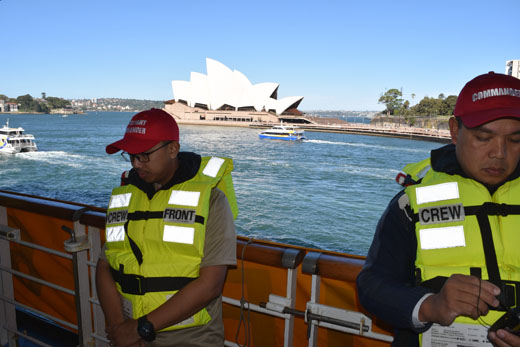
As we stood at our lifeboat stations, Captain Jutten reviewed over the loudspeaker system the procedures that might someday save our lives if, God forbid, the 780-feet-long, 105.8-feet-wide Maasdam were in danger of sinking with a potential 1,258 passengers and 580 crew aboard.
Emergency responses proceed in three stages. The first alert is a short blast on the ship’s horn, followed by a long blast, then three more blasts in rapid succession. This sequence notifies the crew that there is an incident occurring and to report to the area of the ship affected by the incident.
The second alarm is a blast of 15 seconds or longer, prompting guest services to come to a halt and crew members in the various departments to go immediately to their emergency stations. Passengers, meanwhile, are required to go to their staterooms to put on warm clothing and comfortable shoes, and to fetch their personal medications, eye glasses, identification, as well as the life jackets that are stowed in each cabin. They are supposed to wait in the cabin for further instructions. “In most cases,” Captain Jutten informed us, “the incident is resolved, and we continue with our cruise.”
However, he added, “In the unlikely event of a real emergency, we would sound the general alarm—seven short blasts followed by one long blast. That is the signal to proceed to your muster station.”
Children 12 and under are required to wear a color-coded wrist band at all times, and if they are separated from their parents at a time of emergency, they will be escorted by crew members to reunite with them at the assigned muster station.
Nancy’s and my cabin was located on Deck 9, the Verandah Deck, and our Muster Station 10 was on Deck 6, the Lower Promenade Deck. Because elevator service is suspended during emergency drills, that meant walking to the nearest stairwell and descending three decks to our station on the port (left) side of the ship as you face the bow. At this point, in a real emergency, we would stand at the muster station until it became necessary to enter a lifeboat which would be lowered from above. Crew members assigned to each lifeboat are trained to take command. Life jackets are equipped with both a whistle and a light, the latter engineered to illuminate as soon as it comes into contact with water.
Before the drill ended, we were given some safety tips over the loud speaker by Jose Alvarez, who served as our cruise director through the end of his tour at Auckland, New Zealand, 14 days later. He advised us that smoking was permitted only in designated areas, and never to throw anything overboard. Furthermore, he said, because colds and flus can spread quickly through a cruise ship, passengers would be wise to utilize hand sanitizers located throughout the ship.
Private Cabins
Returning to our cabin, we met our cabin steward and his assistant, who both were Indonesians. We found the stateroom ample to hang some clothes, fold others into drawers, and to store our suitcases under the queen-sized bed. At the desk, there was enough drawer space to store souvenirs purchased both aboard the ship and ashore. There were two outlets, one above the desk for American devices, and one below for European appliances. Upon request, Holland America supplied a power strip so I could plug in my computer in addition to other electrical appliances. In one desk drawer was a hair dryer that Nancy needed to use at the desk; there was no plug in the bathroom. What the bathroom did include was good counter space at the sink, a combination bath and shower, and toilet. Outside on the balcony, we found two chairs with separate leg rests. That night and every night thereafter when we returned to our cabin, we’d find on our bed a “When and Where” program for the next day’s activities as well as towels that had been folded by the stewards into little animals.
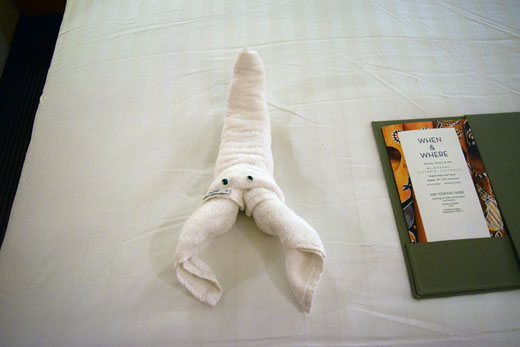
This was our 50th wedding anniversary trip, so we were willing to splurge a little to have our own balcony from which we could scan for other ships, enjoy a nightcap, or get our first view in the morning of a new port. Friends ask if we feel a balcony is really necessary, given the premium one pays for them. I’ll say this, they are very nice, but for people who want to use their money for other purposes, there are plenty of public spaces on the ship to lounge outside, including two swimming pools, and spaces upon the upper decks. The dining room and numerous indoor lounges have picture windows through which one may sea gaze.
Public spaces
For the most part, public activities aboard Maasdam occur on five decks. Deck 6 is the already discussed Lower Promenade Deck, around which many walkers take laps for exercise purposes. On Deck 7, the Promenade Deck, one finds the Main Office, the Shore Excursion Office, the photo gallery, the movie theatre, the demonstration kitchen, various meeting rooms, and displays of art for sale at auction by Park West Gallery. At the bow is the lower portion of the two-story Showroom at Sea, which features lectures during the day and live entertainment at night. At the stern is the lower portion of the two-story Rotterdam Dining Room, where waiters serve breakfast, lunch, and dinner. The center of the ship is dominated by a three-story atrium featuring “Totem,” a sculpture with 2,000 pieces of glass executed by Italian sculptor Luciano Vistosi, who describes the style of his works as “rounded, sinuous sculptures devoid of sharp angles; shapes that appeal for the changing plays of light and also for their tactile qualities; works made by modelling the blown glass with rapid, firm movements, balancing the blown glass while gravity draws it gradually down, and giving form to the creative idea in three minutes at the most; or sculptures made by chiseling and smoothing the glass as though it were marble.”
The attractions on Deck 8, which is known as the Upper Promenade Deck, include the balcony levels of the Showroom at Sea and the Rotterdam Dining Room, at the latter of which the Maasdam crew offers afternoon tea. The deck also includes various clothing, jewelry, and souvenir shops; several lounges with such entertainment as a singing piano player, and a classical pianist and violinist; a casino with slot machines, blackjack and poker and dice tables; a well-stocked library; a digital workshop; a café where they can whip up coffee and tea drinks in various styles; and the Pinnacle Grill, a specialty restaurant featuring Continental fare for which one pays extra.
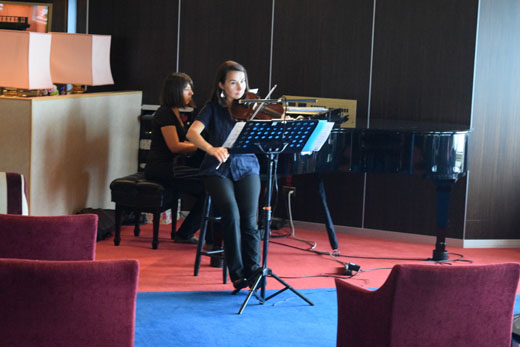
Deck 11 is the Lido Deck, featuring informal, cafeteria style dining indoors, and an outdoor salad, hamburger, and hot dog station next to the main swimming pool. Here too are an observation deck, a fitness center, men’s and women’s locker rooms, aerobics, a beauty salon and spa; whirlpools, and the Canaletto Restaurant, another specialty restaurant, featuring Italian food. (A second swimming pool, known as the Sea View Pool, is located one deck below at the stern of Deck 10.)
Deck 12, the Sports Deck, offers a practice tennis court and basketball court, and is the home of Club HAL, where there are activities for children. Under HAL’s rules, children are required to remain at the club until their parents or guardians come pick them up. The club is stocked with video games, and there are numerous group activities. At the bow of the ship is the Crow’s Nest, a large semi-circular lounge where Team Trivia and Music Trivia are particularly popular activities. In the late evenings, a disc jockey plays dance music from various eras. Some mornings, the Crow’s Nest also was the locale for question-and-answer presentations with various members of the crew.
A smaller Deck 13, Sun Deck, is above, from which one may watch the scenery or spread out a towel and get a sea tan.
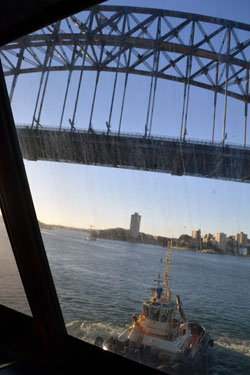
Dining Room
We had dinner that first Thursday night next to a picture window in the Rotterdam Dining Room, where we could watch the Sydney Opera House and the Harbour Bridge slip into the distance as we began our cruise to the next port, which was Melbourne, Australia. A San Diego couple whom Nancy and I have known for more than 40 years, Robert and Helaine Baum, also were on the cruise, and we sat together comparing notes about our separate flights from Los Angeles, our arrivals in Sydney, and what kinds of excursions we had planned throughout the cruise.
A team of three wait staff attended us: a waiter, wine steward, and bus boy, and occasionally a maître d’ would stop by the table just to say hello. Dinner menus typically offer appetizers, soup, salads, entrees of meat, poultry, fish, or vegetables; and desserts. The waiters and busboys are from Indonesia; the wine steward and bar personnel from the Philippines.
For our first night dinner entrées, Nancy chose an eggplant pasta, while I picked the salmon. We both were pleased.
On the Maasdam, one may choose first seating at 5:15 p.m., second seating at 7:45 p.m., and at either of these seatings be guaranteed to be at the same table, with the same fellow passengers, and the same wait staff, who will quickly learn your preferences. The Harrisons and the Baums chose open seating, so that we could go to the restaurant any time in the evening, depending on what other activities were occurring either in port or on the ship. Eventually, however, along with another couple, we settled into a routine of meeting for dinner at 6:45 p.m. We became so predictable that we were assigned to the same table and wait staff, much to our delight.
The Haka
The next day of our cruise, a Friday, was a full day at sea. This is generally a good idea because it allows passengers to familiarize themselves with the ship and to decompress from the stress of airline flights, and land transfers.
Various activities beckoned to us, including talks by crew member David Happe about the attractions of Melbourne and the following port, Burnie, Tasmania, but the most intriguing program of all was a demonstration of the haka, by a Maori troupe who had come aboard from New Zealand.
The haka is a traditional dance, meant either to welcome visitors or to scare enemies, and it includes rhythmic pounding of the chest, stomping of the feet, slapping of the thighs, facial contortions and shouts. If ever you have seen New Zealand’s All Blacks rugby team perform the haka before a match, you get the idea of how intimidating it can be when performed well. The group that came aboard the Maasdam taught the lyrics of one well-known haka, while also demonstrating the moves for passengers, who then did their best to imitate them. A note about Maori spelling: The Wh letter combination at the start of a word is pronounced like an “F.”
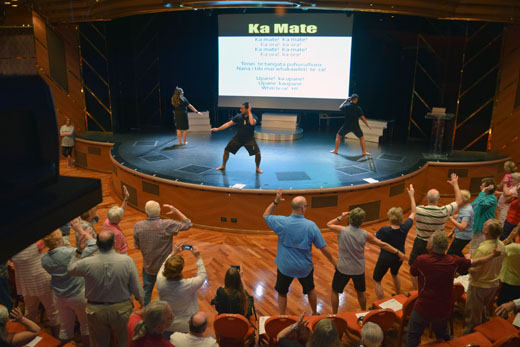
Ka mate! Ka mate! ( I die! I die!)
Ka ora! Ka ora! (I live! I live!)
Ka mate! Ka mate! (I die! I die!
Ka ora! Ka ora! (I live! I live!)
Tenei ne tangata dpuhuaruhuru (This is the hairy man)
Nana I tiki mai (Who fetched the sun)
Whakawhiti t era (And caused it to shine again)
A Upane! Ka upane! (An upward step! Another!)
A Upane! Ka upane! (An upward step! Another!)
Whiti t era! (The sun shines)
Hi! (a loud exclamation)
This particular haka is based on a legend in which Chief Te Rauparaha, leader of one warring tribe, found shelter from his enemies by appealing to a neutral chief, who hid him in a sweet potato pit under the skirts of his wife. According to literature distributed at the demonstration, “This strange act has interesting explanations. Firstly, no self-respecting warrior would dare to hide beneath a woman, but that really confused the enemy. Secondly, the female organs were believed to have a sheltering effect.” The hairy man mentioned in the chant is believed to be the neutral chief. When Te Rauparaha climbed out of the pit into daylight, he exclaimed, “The sun shines!”
Erev Shabbat
In the Half Moon Room, Jews assembled late Friday afternoon for what we hoped would be a Kabbalat Shabbat service. Holland America Lines graciously had laid out a pair of electric Shabbat candles (open flames are not permitted on the ship), yarmulkes, prayer books from the Reform movement, two bottles of kosher wine, two challahs, a plate of gefilte fish, and a plate of cookies. Only nine of us showed up, of whom eight were Jewish, and one was married to a Jew. Not having a minyan, we introduced ourselves to one another, played Jewish geography, and intoned the prayers over the candles, wine, and bread.
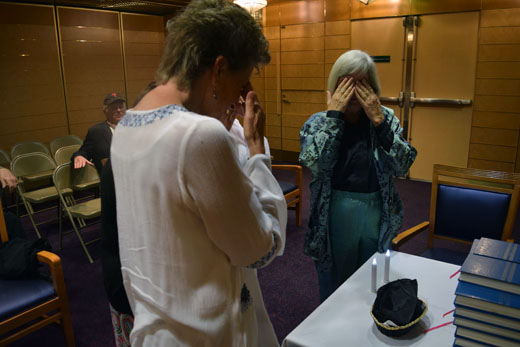
Besides ourselves and the Baums, our group included Alan and Suzanne Posner from Boston; and Larry and Adrienne O’Hare from Tucson. A single woman named Marlene, whose surname I don’t know, mentioned that she was moving to Florida. As we exchanged information, we learned that Alan was an attorney, and Suzanne was active in her congregation, and that Larry had once worked for the Secret Service, but later went into a career in real estate. Adrienne, we learned, was a psychologist.
If not for religious reasons, then for social reasons, I recommend every Jewish passenger attend the first Friday night Shabbat service on their cruise. It’s a nice way to develop an acquaintance, and possibly a friendship, with people with whom you know you have something in common. The Baums and we became friendly with these two couples, as well as with other Jews who joined the cruise two weeks later in Auckland and whom we met on subsequent Erev Shabbats.
*
Harrison is editor of San Diego Jewish World. He may be contacted via Donald.harrison@sdjewishworld.com
Pingback: Real Tasmanian Devil unlike Warner Bros’ ‘Tazzy’ | San Diego Jewish World
Pingback: Retirees, tourists warmly welcome in Burnie | San Diego Jewish World